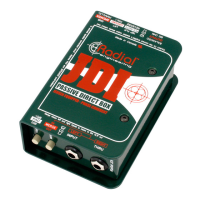Part 7 - Frequently Asked Questions
Q: What is the difference between active & passive?
A: Active DI's have a built-in pre-amp that requires battery or 48V phantom power to run, while passive DI's use a transformer
to convert the signal and do not require any power supply. Both ‘transform’ or convert the instrument’s high-impedance output
to a low impedance balanced microphone level. This allows long cable runs without adding unwanted noise. Passive boxes
have the advantage of providing transformer isolation, which can reduce ground hum and noise in systems.
Q: Which is better – active or passive?
A: Both have their place just like dynamic and condenser microphones. Passive DI's are often easier to use because they
do not require power while active DI's tend to have more reach. As a rule, passive direct boxes are preferred for electrically
powered devices such as keyboards and electronic drums.
Q: Why do people use passive direct boxes?
Passive direct boxes are often chosen as they are ‘plug & play’ easy to use. When equipped with a high quality transformer,
they can handle exceptionally high signal levels without harmonic distortion and a good one like the JDI will process the
signal without introducing artifacts such as phase distortion. Best of all, passive DI’s eliminate ground loops!
Q: Why do people use active direct boxes?
A: There are two reasons that active DI boxes like the Radial J48 have become popular. To get good sound with a passive
direct box, you need to use a high quality transformer like a Jensen, which can be quite expensive. This cost dissuades
many manufacturers from building passive DI's, while an active direct box can be made much more inexpensively. The other
reason is that back in the 1970's and 1980's when DI's rst showed up, most instruments used passive pickups and these
generally had very low output levels. Passive DI's with inefcient transformers would ‘load’ down the pickup and cause the
sound to change. Active (buffered or amplied) direct boxes could be made with a high input impedance that would not load
down the pickups, which solved the loading issue.
Q: Can you explain impedance loading?
A: Years ago, most instruments used passive, low output pickups. Passive pickups "see" the device it is connected to, such
as an amplier input, as a load it must drive with it's output signal. Musicians found that connecting their passive instruments
to both a direct box and an amplier caused the sound to change. This happens because the signal is split between two
impedance loads. The instrument amplier presents one load on the pickups and the DI's transformer adds a second load.
Each device draws on the passive signal and this reduces the level going to the instrument amplier causing it to sound
different when compared to a straight instrument-to-amp connection.
Radial Engineering JDI
™
User Guide
12
True to the Music
True to the Music

